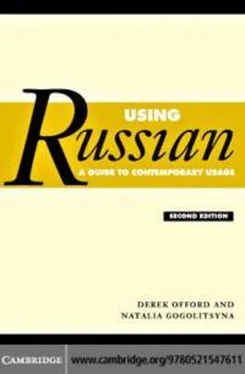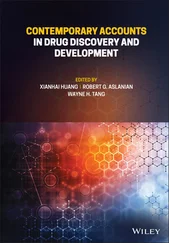Derek Offord - Using Russian - A Guide to Contemporary Usage
Здесь есть возможность читать онлайн «Derek Offord - Using Russian - A Guide to Contemporary Usage» весь текст электронной книги совершенно бесплатно (целиком полную версию без сокращений). В некоторых случаях можно слушать аудио, скачать через торрент в формате fb2 и присутствует краткое содержание. Год выпуска: 2005, Издательство: Cambridge, Жанр: Языкознание, на английском языке. Описание произведения, (предисловие) а так же отзывы посетителей доступны на портале библиотеки ЛибКат.
- Название:Using Russian : A Guide to Contemporary Usage
- Автор:
- Издательство:Cambridge
- Жанр:
- Год:2005
- ISBN:нет данных
- Рейтинг книги:4 / 5. Голосов: 1
-
Избранное:Добавить в избранное
- Отзывы:
-
Ваша оценка:
- 80
- 1
- 2
- 3
- 4
- 5
Using Russian : A Guide to Contemporary Usage: краткое содержание, описание и аннотация
Предлагаем к чтению аннотацию, описание, краткое содержание или предисловие (зависит от того, что написал сам автор книги «Using Russian : A Guide to Contemporary Usage»). Если вы не нашли необходимую информацию о книге — напишите в комментариях, мы постараемся отыскать её.
Using Russian : A Guide to Contemporary Usage — читать онлайн бесплатно полную книгу (весь текст) целиком
Ниже представлен текст книги, разбитый по страницам. Система сохранения места последней прочитанной страницы, позволяет с удобством читать онлайн бесплатно книгу «Using Russian : A Guide to Contemporary Usage», без необходимости каждый раз заново искать на чём Вы остановились. Поставьте закладку, и сможете в любой момент перейти на страницу, на которой закончили чтение.
Интервал:
Закладка:
проли´т, Some milk has been spilt .
r Less differentiation than in the standard language of subordinating conjunctions (which in any case occur less in R1 than in R2 and
especially R3; see 11.12.2); correspondingly broader use of certain conjunctions, especially: что in causal sense, e.g. Oн хохо´чeт нaд
нa´ми, что глу´пы дaк, He’s laughing at us for being so stupid ; and кaк in (a) conditional sense (=e´сли, if ), e.g. Кaк ти´хо – поe´ду, a вe´тeр –
дaк ни зa что, If it’s calm I’ll go, but if it’s windy I certainly shan’t ; (b) causal sense (=потому´ что, because ), e.g. Beдь я´-то нe нaпишу´, кaк я нeгрa´мотнa, I shan’t write myself, because I can’t write ; (c) temporal sense (=когдa´, when ), e.g. Кaк жa´рко бы´ло, дaк ко´шки в трaву´
ложи´лись, When it was hot the cats would lie down in the grass .
r Use of the emphatic post-positive particle -то (see 5.4 on use of this particle in the standard language). In some dialects (esp N and E) the article changes according to the gender and number of the noun, i.e.
сто´л-от, кры´шa-тa, окно´-то, столы´-тe. In some C dialects the forms
-ту and -ти оr -ты may be used for the sake of harmony with the
ending of the noun to which the particle is attached e.g. нa бeрeгу´-ту, бeз со´ли-ти.
1.6
Current debate about standard Russian
We return at this point to the notion of a linguistic standard that was broached in section 1.2 above. By linguistic standard we mean a 25
1
Varieties of language and register
canonical form of a language which grammarians and lexicographers
have sought to codify and which certain works of literature are felt to exemplify. In some countries it is the function of some institution (e.g.
the Académie franc¸aise in France) to preserve this standard. (In Russia this function is fulfilled by the V. V. Vinográdov Russian Language
Institute of the Russian Academy of Sciences, the Linguistics Institute of the Russian Academy of Sciences, the A. S. P úshkin Russian
Language Institute, and other institutions.) It will be clear from what was said in 1.2 that the standard is not only the uniform language that educated speakers are believed actually to use but also an exemplary language that it is felt speakers of the language in general ought to aspire to use. In other words, the term ‘standard’ when applied to a language has both a descriptive and a prescriptive sense.
This book is primarily descriptive. We aim to acquaint students with contemporary Russian usage (its registers and functional styles, lexis, morphology, syntax and stress) as we find it rather than to exhort
students to adhere exclusively to usage that a purist might consider as conforming to an educated standard. We therefore have no hesitation
in pointing out non-standard features of contemporary Russian. This
leaning towards descriptivism rather than prescriptivism, which is in the spirit of the series to which this book belongs, is intended to help the foreign student to become aware of the full stylistic and expressive range that is available to the Russian native speaker. Evidence of such awareness may raise the foreign learner’s authority in the eyes of native speakers.
At the same time it is essential that a foreigner learning a language should know what native speakers consider to be standard (the norm at which they will probably feel foreigners should aim) and what they
consider sub-standard (and may therefore expect the foreign learner to eschew). In particular, the foreign learner should understand that the freedom that he or she enjoys to use the resources of the language
being acquired, especially its sub-standard forms, is on the whole more limited than that enjoyed by native speakers. This statement is true as a matter of fact, inasmuch as there will no doubt be lacunae in
knowledge of vocabulary, idiom and grammar that inhibit the foreign
user of a language. It also holds good with respect to etiquette. For the relatively limited nature of the foreigner’s understanding of the cultural contexts in which the foreign language is used is likely to be felt at some level by native speakers to impose a duty on the foreigner to
observe a certain humility and linguistic restraint. The disapproval of native speakers may easily be aroused by deployment of sub-standard
forms by the foreign learner in an inappropriate context.
Debates about what the standard form of a language is or should be
and about the desirability and feasibility of preserving, purifying or reforming the language are commonplace among peoples whose
languages are widely used for political, commercial, administrative, literary and other purposes as well as for everyday social intercourse.
With respect to the English language, for example, there has in recent 26
1.6
Current debate about standard Russian
years been much discussion about such questions as the following. Is standard spoken English the same thing as standard written English?
(It is widely thought by socio-linguists not to be.) Is there such a thing as standard spoken English at all? Is it right to attempt to impose a standard spoken form of English, including received pronunciation,
through the educational system? What are the social implications of
such a policy? What political assumptions lie behind the positions
taken up on such issues? Such debates are often fuelled by concern that what is thought to be a standard form of language is being polluted by the increasing toleration of non-standard pronunciation (e.g. the
pronunciation that characterises what is known as estuary English), or by the influx into a language of lexis that is perceived by educated users as coarse or vulgar, or by the establishment of grammatical
phenomena that are considered by such users to be incorrect.
A debate about the state of the Russian standard began in the late
1980s and has quickened in the 1990s and the early years of the
twenty-first century. This debate needs to be seen against the
background of the political, economic, social and cultural changes
(прeобрaзовa´ния) that have affected the Russian language in the
post-Soviet period. For example, Russians now have much closer
contact with the West, as a result of increased opportunities for travel abroad, the influx of a larger number of foreigners into Russia than in the Soviet period, and easier access to Western culture, particularly material and popular culture, through the media and the internet. The one-party state of Soviet times has given way to a state with democratic institutions in which political parties of various complexions compete with one another. A free-market economy is developing. Mass media,
including new and independent television stations and newspapers,
have proliferated. Women have asserted themselves to a greater extent than before. The Soviet cultural legacy is receding.
The effect of these changes on the Russian language, especially in
the areas of lexis and style, may be viewed in different ways. On the one hand they may be seen positively as having enriched Russian with numerous neologisms expressing new concepts or presenting old
concepts in a new light (see 5.1 below). They have also helped to release the language from the ideological straitjacket of the Soviet era.
It is perhaps indicative of a recognition of the positive effect, or at least the naturalness and legitimacy, of linguistic change that Russian
Читать дальшеИнтервал:
Закладка:
Похожие книги на «Using Russian : A Guide to Contemporary Usage»
Представляем Вашему вниманию похожие книги на «Using Russian : A Guide to Contemporary Usage» списком для выбора. Мы отобрали схожую по названию и смыслу литературу в надежде предоставить читателям больше вариантов отыскать новые, интересные, ещё непрочитанные произведения.
Обсуждение, отзывы о книге «Using Russian : A Guide to Contemporary Usage» и просто собственные мнения читателей. Оставьте ваши комментарии, напишите, что Вы думаете о произведении, его смысле или главных героях. Укажите что конкретно понравилось, а что нет, и почему Вы так считаете.












